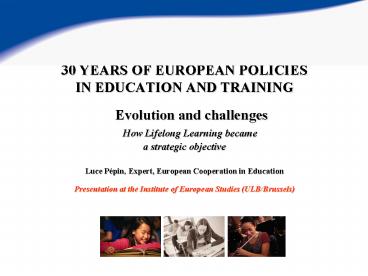30 YEARS OF EUROPEAN POLICIES - PowerPoint PPT Presentation
1 / 15
Title:
30 YEARS OF EUROPEAN POLICIES
Description:
Luce P pin, Expert, European Cooperation in Education ... favourable: 1985 = Citizens' Europe/Milan EC; social dialogue relaunch; Single Act/HR. ... – PowerPoint PPT presentation
Number of Views:44
Avg rating:3.0/5.0
Title: 30 YEARS OF EUROPEAN POLICIES
1
- 30 YEARS OF EUROPEAN POLICIES
- IN EDUCATION AND TRAININGEvolution and
challenges - How Lifelong Learning became
- a strategic objective
- Luce Pépin, Expert, European Cooperation in
Education - Presentation at the Institute of European Studies
(ULB/Brussels)
2
EUROPEAN INSTITUTIONS AFTER THE WAR
- Political choice Intergovernmentalism
- 48 The OECE (predecessor of the OECD)
- 48 The Western Union (54 WEU/UEO)
- 49 The Council of Europe
3
THE COMMUNITY FIRST STEPS
- May 50 Schuman Declaration
- April 51 Signing of the Treaty of Paris
ECSC/CECA - May 52 Signing in Paris of the ECD/CED Treaty
- March 57 EEC and Euratom Treaties signed in
Rome (article 128 EEC on VET policy)
4
EDUCATION COOPERATION BEFORE COMMUNITY
INVOLVEMENT
- 49 European conference on culture (European
Centre of Culture and College of
Europe/Bruges) - 54 European Cultural Convention (Council of
Europe). - 53/56/59 First conventions on equivalence of
university Diplomas and study periods - 59 Dijon Creation of the CRE (Eur. Rectors
Conf) - 62 Creation of the CDCC/Council of Europe
- 67 Creation of the OECD/CERI (Centre for
Educational Research and Innovation)
5
MAJOR LANDMARKS OF EC COOPERATION IN EDUCATION
- 1957-1971 Pre-history
- 1971-1985 Foundation years of education
cooperation. - 1985-1992 Programmes recognition in the
Treaty - 1992-2000 Towards the knowledge society and LLL
- 2000-2005 The Lisbon strategy towards an
integrated framework of cooperation
6
1957-1971 Pre-history for education
cooperation
- Education totally absent from the Rome Treaty
(EEC). The subject is taboo ! - Council of Europe is the main actor .
- VET first developments (63 Decision, CCFP), not
commensurate with legal basis. Role of ESF. - Context growing interest for a Community
involving young people (The Hague 1969 European
Summit)
7
1971-1985 Foundation years for education
cooperation
- November 71 first meeting of Education
ministers first activity programme for VET.
1975 CEDEFOP creation - June 1974 Resolution on education cooperation
fields and principles are set. - February 76 First Action Programme. Education
Committee established. - However, still no legal basis
- 1981 Education joins the Employment and Social
Affairs DG
8
1985-1992 Programmes and at last legal
recognition
- The context is favourable 1985 Citizens
Europe/Milan EC social dialogue relaunch Single
Act/HR. - 1985 Gravier Judgement HE covered by treaty!
- Launch of major programmes (mainly HE VET)
COMETT, ERASMUS, LINGUA, etc.. actions to
support the European dimension of ed. - 1989 creation of Task Force Human Resources ETY
- Education at last in the Treaty (Maastricht 1992)
9
1992-2000 Towards the Knowledge Society
- Years of reflection and progressive change in
paradigm - Context Historical enlargement and growing
globalisation - 1993 White Paper on Growth/Competitiveness/Emplo
yment - 1995 White Paper on the Learning Society
- 1996 European Year of LLL
- Programmes are rationalised (from six to two)
opening to CEECs - 1999 Bologna process - a quantum leap for
higher education!
10
2000-2006Lisbon Strategy and an integrated
cooperation framework
- 2000 March Lisbon European Council - The Lisbon
Strategy - 2001 Common objectives set new cooperation
approach/OMC - 2002 10 years Work programme Copenhagen
Declaration - 2003 Five benchmarks to monitor progress
- 2004 ET 2010 Call for urgent reforms
- 2004 LLL programme the integrated approach
- 2005 Relaunch of the Lisbon Strategy (Mid-Term
Review). - 2006 Key issues - Efficiency and
equity - Commission proposed the EQF
11
WHAT DOES HISTORY SHOW?
- The uniqueness of the ET fields at EU level
subsidiarity, action close to citizens.. - How LLL became the strategic objective for all
actions in the fields of ET. - The role played by the general EU context
- The role played by the actors at all levels
Commission, EP, Court of Justice, MS - That much remains to be done.
12
MORE NEEDS TO BE DONE TO MEET THE COMMON
EDUCATION OBJECTIVES SET FOR 2010!
13
EDUCATION MINISTERS DEFINE EU BENCHMARKS
- By 2010
- Less than 10 early school leavers
- Decreased of 20 of low-achieving 15-year-olds in
reading literacy - Completion of upper-secondary education by 85 of
22-year-olds - Increase by at least 15 of the number of
graduates in mathematics, science and technology
decrease of gender imbalance - Participation in lifelong learning should be at
least 12.5 of the adult working age population
(25-64 age group).
14
Education within the Commission services
- 1971 Creation of 2 structures under direct
responsiblity of Commissioner A. Spinelli
(Groupe Enseignement et Education et Groupe de
Coordination interservices) - 1973 Education becomes an integral part of DG
XII (research, science and education) - 1981 ET are moved to DG V Employment, Social
Affairs and Education (creation of a
Directorate for E, T Y.) - 1989 Creation of the TFHR for Education,
Training and Youth - 1995 TFRH transformed into a DG (DG XXII for E,
T Y) - 1999 DG Education and Culture
15
- It is precisely the creative opposition between
the diversity of national systems and the growing
similarity of our problems that provides one of
the main raison dêtre of European cooperation - Jacques Delors (1994)































